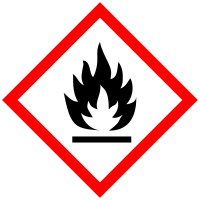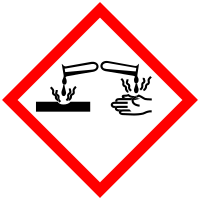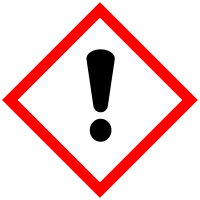
Improving Member States preparedness to face an HNS pollution of the Marine System (HNS-MS)
Acetic Anhydride
Description Top
| CAS number | 108-24-7 |
| UN number | 1715 |
| Chemical formula | C4H6O3 |
| Standard European Behaviour Classification (SEBC) | Dissolves (D) |
GESAMP Hazard profile
| A1 | A2 | B1 | B2 | C1 | C2 | C3 | D1 | D2 | D3 | E1 | E2 | E3 |
| 0 | R | 1 | NI | 1 | 0 | 2 | 3 | 3 | A | NI | D | 3 |
Marine pollution Classification (MARPOL Annex II)
| Category | Description |
| Z | Noxious Liquid Substances which, if discharged into the sea from tank cleaning or deballasting operations, are deemed to present a minor hazard to either marine resources or human health and therefore justify less stringent restrictions on the quality and quantity of the discharge into the marine environment. |
Alternate names for this chemical
Acetanhydride
Acetic Acid Anhydride
Acetyl Anhydride
Acetyl Ether
Acetyl Oxide
Ethanoic Anhydrate
Ethanoic Anhydride
Ethanoic Acid Anhydride
Anhydride Acetique
Acetic Anhydride
Anhydryde Acetique
Acetic Acid Anhydride
Acetyl Anhydride
Acetyl Ether
Acetyl Oxide
Ethanoic Anhydrate
Ethanoic Anhydride
Ethanoic Acid Anhydride
Anhydride Acetique
Acetic Anhydride
Anhydryde Acetique
Physico-chemical properties Top
| Chemical formula | C4H6O3 | ||
| Molar mass | 102.09 [g/mol] | ||
| State | Liquid at 25°C and 1 atm | ||
| Fusion temperature | -73.5 [°C] | ||
| Boiling temperature | 139 [°C] | ||
| Critical temperature | 606 [°C] | ||
| Density |
|
||
| Surface tension |
|
||
| Kinematic viscosity |
|
||
| Hydrosolubility |
|
||
| Vapour pressure |
|
||
| Critical pressure | 4000000 [Pa] | ||
| Vapour density | 3.1 | ||
| Flash point (Pensky-Martens closed cup) | 49 [°C] | ||
| Flash point (Cleveland open cup) | 54 [°C] | ||
| Lower explosivity limit (LEL) | 2.7 [%] | ||
| Upper explosivity limit (UEL) | 10.3 [%] | ||
| Combustion enthalpy | 16400000 [J/Kg] | ||
| Specific heat capacity | 1648 [J/(Kg·K)] | ||
| Combustion efficiency | 98 [%] | ||
| Mass flow rate of the combustion surface | 0.03 [Kg/(m²·s)] | ||
| Radiative fraction | 23 [%] | ||
| Henry's constant | 0.57 [mol/(m³·Pa)] |
Behaviour Top
| Log Kow | -0.58 |
| Log Koc | 1.11 |
| Hydrolysis (Half-life) | 1 day |
| Biodegradation in estuary environment (Half-life) | 10 days |
| Biodegradation in marine environment (Half-life) | 10 days |
| Standard European Behaviour Classification (SEBC) | Dissolves (D) |
| Bioconcentration factor (BCF) | 1 |
Ecotoxicity Top
| Lowest median lethal concentration (LC50) on algae | 9 [mg/l] | ||
| Lowest median lethal concentration (LC50) on crustacean | 55 [mg/l] | ||
| Lowest median lethal concentration (LC50) on fishes | 265 [mg/l] | ||
| Highest no observed effect concentration (NOEC) on algae | 9 [mg/l] | ||
| Highest no observed effect concentration (NOEC) on crustacean | 31.4 [mg/l] | ||
| Highest no observed effect concentration (NOEC) on fishes | 34.3 [mg/l] | ||
| Assessment factor (AF) |
|
||
| Predicted No Effect Concentration (PNEC) |
|
Hazards Top



Danger
| IDLH | 200 [ppm] |
Hazards statements
Physical
H226
Flammable liquid and vapour.
Health
H302
Harmful if swallowed.
H314
Causes severe skin burns and eye damage.
H332
Harmful if inhaled.
Precautionary statements
Prevention
P210
Keep away from heat/sparks/open flames/hot surfaces. No smoking.
P233
Keep container tightly closed.
P235
Keep cool.
P240
Ground/bond container and receiving equipment.
P241
Use explosion-proof electrical/ventilating/lighting/.../equipment.
P242
Use only non-sparking tools.
P243
Take precautionary measures against static discharge.
P260
Do not breathe dust/fume/gas/mist/vapours/spray.
P261
Avoid breathing dust/fume/gas/mist/vapours/spray.
P264
Wash ... thoroughly after handling.
P270
Do no eat, drink or smoke when using this product.
P271
Use only outdoors or in a well-ventilated area.
P284
Wear respiratory protection.
Response
P303
IF ON SKIN (or hair):
P310
Immediately call a POISON CENTER or doctor/physician.
P320
Specific treatment is urgent (see ... on this label).
P330
Rinse mouth.
P370
In case of fire:
P378
Use ... for extinction.
P301 + P312
IF SWALLOWED: Call a POISON CENTER or doctor/physician if you feel unwell.
P304 + P340
IF INHALED: Remove victim to fresh air and keep at rest in a position comfortable for breathing.
Storage
P405
Store locked up.
P403 + P233
Store in a well-ventilated place. Keep container tightly closed.
Disposal
P501
Dispose of contents/container to ...
GESAMP Top
GESAMP Hazard profile
| A1 | A2 | B1 | B2 | C1 | C2 | C3 | D1 | D2 | D3 | E1 | E2 | E3 |
| 0 | R | 1 | NI | 1 | 0 | 2 | 3 | 3 | A | NI | D | 3 |
A1: Bioaccumulation
| Rating | Description |
| 0 | No potential to bioaccumulate |
A1a:
| Rating | Description | Criteria [mg/l] |
| 0 | No potential to bioaccumulate | Log Kow < 1 |
A1b:
| Rating | Description | Criteria |
| 0 | No potential to bioaccumulate | No measurable bioconcentration factor (BCF) |
A2: Biodegradation
| Rating | Description |
| R | Readily biodegradable |
B1: Acute aquatic toxicity
| Rating | Description | Criteria [mg/l] |
| 1 | Practically non-toxic | 100 < LC/EC/IC50 ≤ 1000 |
B2: Chronic aquatic toxicity
| Rating | Description |
| NI | No Information |
C1: Acute oral toxicity
| Rating | Description | Criteria [mg/Kg] |
| 1 | Slight | 300 < AOTE ≤ 2000 |
C2: Acute dermal toxicity (skin contact)
| Rating | Description | Criteria [mg/Kg] |
| 0 | Negligible | ADTE > 2000 |
C3: Acute inhalation toxicity
| Rating | Description | Criteria [mg/l] (4 hours exposure) |
| 2 | Moderate | 2 < AITE ≤ 10 |
D1: Skin irritation or corrosion
| Rating | Description | Sign | GHS category |
| 3 | Severely irritating or corrosive | Severe irritation indi | Corrosive Category 1 |
D2: Eye irritation
| Rating | Description | Sign | GHS category |
| 3 | Severely irritating or corrosive | Severe conjunctoblepha | Irritant Category 1 |
D3: Long-term health effects
| Notation | Hazard endpoint | Description | GHS category |
| A | Aspiration | Lung injury or chemical pneumonia following aspiration of a chemical through the oral or nasal cavity into the trachea or lower respiratory system | Category 1 for Aspiration Toxicity |
E1: Tainting of seafood
| Rating | Description |
| NI | No Information |
E2: Behaviour of chemicals in the marine environment
| Rating | Description |
| D | Dissolves |
E3: Interference with the use of coastal amenities
| Rating | Interference | Description | Interpretation | Warning |
| 3 | Highly objectionable | 1 is highly acutely toxic; and/or 2 is severely irritant or corrosive to skin or eyes; and/or 3 is carcinogenic, mutagenic or reprotoxic; and/or 4 is a floater or persistent floater with associated health effects | 1 C1 and/or C2 and/or C3 = 4; and/or 2 D1 or D2 = 3, 3A, 3B, or 3C; and/or 3 D3 contains C, M or R; and/or 4 E2 = F or Fp and D3 contains Ss, Sr, T, A, N, or I | Warning issued leading to the closure of amenities |
GHS Security Information



Danger
About the project
HNS-MS is a decision-support tool that Belgian and French maritime authorities as well as coastguard stations can activate in order to forecast the drift, fate and behavior of acute marine pollution by Harmful Noxious Substances (HNS) accidentally released in the marine system.
Contact us
Copyright © 2015–2026 HNS-MS Consortium
 HNS-MS has been funded by DG-ECHO under agreement ECHO/SUB/2014/693705 and runs from 1 January 2015 to 31 March 2017.
HNS-MS has been funded by DG-ECHO under agreement ECHO/SUB/2014/693705 and runs from 1 January 2015 to 31 March 2017.